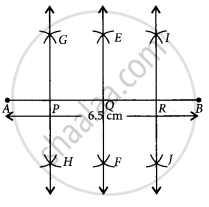Advertisements
Advertisements
Question
Draw a line segment of length 6.5 cm and divide it into four equal parts, using ruler and compasses.
Solution

Steps of construction:
(i) Draw a line segment AB = 6.5 cm.
(ii) With A and B as centres and radius more than `1/2` (AB), draw arcs one on each side of AB, these arcs cuts each other at E and F.
(iii) Join EF, which cuts AB at Q.
(iv) With centres A and Q and radius more than `1/2` AQ, draw arcs one on each side of AB, these arcs cuts each other at G and H.
(v) Join GH, which cuts AB at P.
(vi) Similarly, with centres B and Q and radius more than `1/2` (BQ), draw arcs one on each side of AB, these arcs cuts each other at I and J.
(vii) Join IJ, which cuts AB at R.
(viii) Now, point P, Q and R divide the line segment AB in four equal parts.
Thus AP = PQ = QR = RB.
APPEARS IN
RELATED QUESTIONS
Draw a line segment PQ = 4.8 cm. Construct the perpendicular bisector of PQ.
Draw a line segment AB = 5.5 cm. Mark a point P, such that PA = 6 cm and PB = 4.8 cm. From point P, draw a perpendicular to AB.
Draw a line segment AB of length 5.5 cm. Bisect it using a compass and ruler.
It is possible to draw two bisectors of a given angle.
Bisect ∠XYZ of figure.
Draw `overline"AB"` of length 7.3 cm and find its axis of symmetry.
Draw a line segment of length 9.5 cm and construct its perpendicular bisector.
Draw a line segment of length 12.8 cm. Using compasses, divide it into four equal parts. Verify by actual measurement.
Repeat Question 6, if `overline"AB"` happens to be a diameter.
Draw any angle with vertex O. Take a point A on one of its arms and B on another such that OA = OB. Draw the perpendicular bisectors of `overline"OA"` and `overline"OB"`. Let them meet at P. Is PA = PB ?
